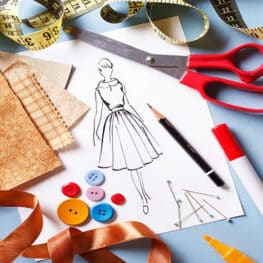Diploma in Fashion Design and Fashion Product Management (One Year Course)
Objectives:
- To impart knowledge in fashion design, retail management and fashion industry.
- To prepare the students with necessary techniques like drawing, color, material usage, CAD, etc., used by designers throughout the world.
Semester 1
Module 1: Fashion Design and Illustration (50hrs)
- Elements and Principles of design
- Color schemes and colors psychology
- Introduction to fashion and garment industry
- Introduction to world fashion
- Introduction to design process, development of mood board, development of design collections for garments
Module 2 : Basic of pattern making and garment construction (50 hrs)
- Introduction to pattern making, terminology, tools and equipment’s
- Introduction to sewing machines, types and their parts –functions
- Introduction to measurement and its importance
- Fabric preparation for garment construction, principles of layout
- Drafting of basic bodice, skirts and sleeve
- Conversation of basic blocks to different styles
- Introduction to sewing techniques likes seams, tucks, pleats, gathers
- Making of 3 different garments
Module 3: Textile science (30 hrs)
- Introduction to natural and commercial synthetic fibers
- Important properties of fiber.
- Types of Yarn
- Different types of fabric and weaves
- Brief introduction to dyeing and printing
Module 4 (30 hrs)
- Fundamentals of CAD, Design process
- Basic coral draw- tools, motif development and application
- Basics of Photoshop
- Logo designing and application
Module 5 (30hrs )
- Fundamentals of Production management
- Word / Advance excel
- Planning and costing management on excel
Project 1 (50 hrs)
Semester 2
Module 6: Advanced pattern making and garment construction (55hrs)
- Dart manipulation
- Pattern making and construction of frocks (2 types)
- Pattern making and construction of salwar suits (2types)
- Pattern making and construction of blouses ( 2 types)
- Development of design collection (5-6 garments)
Module 7: Computer aided Fashion Design (30 hrs)
- Basic Croquie – features/ hairstyle, different poses.
- Flat Designing of casual, formal wears
- Flat Designing of sports, beach and nightwear
- Flat Designing of party and bridal wear.
- Adobe photo shop- Draping( casual, formal, sports, beach, night, party and bridal wear)
Module 8: Fashion ornamentation (30 hrs)
- Introduction to hand embroidery stitches 15 types
- Introduction to traditional embroidery of Indian
- Learning Free style embroidery and fabric manipulation
- Learning of Tie-dye and block printing methods
Module 9: Fashion merchandising (45 hrs)
- Introduction- Fashion industry buying house, export home, domestic selling, whole sale and retail marketing sourcing of fabrics and trims
- Different departments in garment industry
- Merchandising- Role of merchandiser, sample, production, quality, visual merchandising
- Plan collection
- Production planning
- Documentation- export document, technical pack and others
- Costing studies
- Entrepreneurship- boutique, industry, market serve


